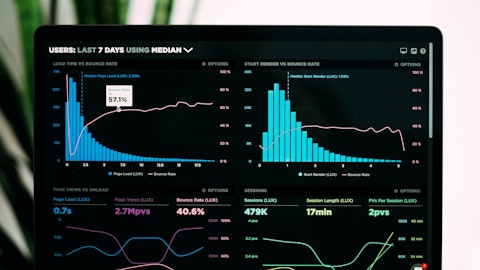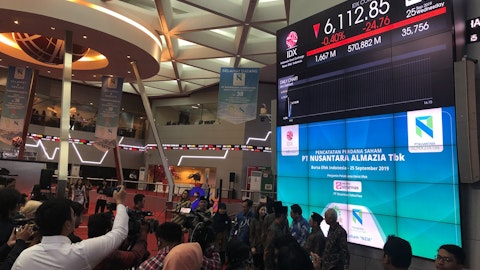Prudential Financial, Inc. (NYSE:PRU) Q3 2023 Earnings Call Transcript November 2, 2023
Operator: Ladies and gentlemen, thank you for standing by, and welcome to Prudential’s quarterly earnings conference call. [Operator Instructions]. As a reminder, today’s call is being recorded. I will now turn the call over to Mr. Bob McLaughlin. Please go ahead.
Robert McLaughlin: Good morning, and thank you for joining our call. Representing Prudential on today’s call are Charlie Lowrey, Chairman and CEO; Bob Falzon, Vice Chairman and Head of International Businesses; and PGIM, our Global Investment Manager; Caroline Feeney, Head of U.S. Businesses; Ken Tanji, Chief Financial Officer; and Rob Axel, Controller and Principal Accounting Officer. . We will start with prepared comments by Charlie, Rob and Ken, and then we will take your questions. Today’s presentation may include forward-looking statements. It is possible that actual results may differ materially from the predictions we make today. In addition, this presentation may include references to non-GAAP measures. For a reconciliation of such measures to the comparable GAAP measure and a discussion of factors that could cause actual results to differ materially from those in the forward-looking statements, please see the slides titled Forward-Looking Statements and Non-GAAP Measures in the appendix of today’s presentation and the quarterly financial supplement, both of which can be found on our website at investor.prudential.com.
And now I’ll turn it over to Charlie.
Charles Lowrey: Thank you, Bob, and thanks to everyone for joining us today. Our third quarter results reflect continued momentum across our businesses, excluding the benefits from strong sales and the fifth consecutive quarter of underlying earnings growth. We continue to execute on our strategy to become a higher growth, less market-sensitive and more nimble company. This quarter, we increased our capital efficiency and enhanced our capabilities in mutually reinforcing business system. We are also optimizing our operating model to drive both efficiency and growth. Our strategic progress and financial strength position us well to navigate the current macroeconomic environment and maintain a disciplined approach to capital deployment.
Turning to Slide 3. During the quarter, we launched Prismic, a life and annuity reinsurance company alongside Warburg Pincus and other investors. It is one of our most exciting opportunities to drive sustainable long-term growth across our investment management, insurance and retirement businesses. Through Prismic, we can ensure portions of our life and annuity in-force and new business to reduce market sensitivity, free up capital and invest in growth opportunities. Prismic can also offer its services to other insurance companies in need of reinsurance support, tapping into additional sources of third-party capital to drive further growth. In addition, Prismic expands PGIM’s assets under management. Prismic is a great example of how Prudential can unlock value for customers, shareholders and other stakeholders with our mutually reinforcing business system, which combines the power of our brand, global asset and liability origination capabilities and multichannel distribution.
We’re also growing and investing in our businesses to better serve our customers through both the products and services we offer and through the ways we do business. Our distribution channels continue to evolve and expand to provide more people around the world with our products and services in the way they want them. I’ll provide a few examples from the third quarter. In Brazil, we achieved the second consecutive quarter of record sales, driven by continued expansion in the third-party distribution channel and the strong performance of our Life Planner channel. In the U.S., individual retirement strategies posted its strongest sales quarter in 3 years, driven by the continued success of FlexGuard as well as the expansion of our fixed annuity suite with the launch of our new Wealth Guard multiyear guaranteed annuity.
Within the Institutional market, retirement strategy secured $2.5 billion in new pension risk transfer transactions to the health savings account space by securing a $1.2 billion transaction with a top HSA provider, expanding our addressable market. And in our Prudential Advisors distribution channel, we announced a strategic relationship with LPL Financial, which upon completion in the latter part of next year, will enhance both our adviser and customer experience by leveraging LPL’s expertise, industry-leading technology and robust broker dealer and registered investment adviser services. Alongside these investments in our businesses, we continue to focus on customer service through enhanced sales and claims platforms. For example, this year, we have announced 7 customer experience technology partnerships within group insurance.
These include Enrolofy, an innovative platform transforming the enrollment experience for millions of employees and Evolution IQ, an AI-driven platform that will streamline the disability claims process. We’re also working to create a leaner, faster and more agile company so that we can better meet the changing needs and expectations of our customers around the world while driving growth and efficiency to further strengthen our competitive position. We’re taking new steps to simplify our organizational structure by reducing management layers, complexity and costs while making investments in technology and data platforms. Our goal is to empower faster decision-making and bring our integrated business teams closer to our customers and clients.
Turning now to Slide 4. Prudential’s rock solid balance sheet and robust risk and capital management frameworks have allowed us to confidently navigate the current macroeconomic environment. Our AA financial strength is supported by our strong capital position, including approximately $48 billion of unrealized insurance margins, $4.3 billion in highly liquid assets at the end of the third quarter and a high-quality, well-diversified investment portfolio and disciplined approach to asset liability management. Moving to Slide 5. Our disciplined approach to capital deployment, coupled with the added capital efficiency from the Prismic transaction enables us to effectively balance investing in the long-term growth of our businesses with returning capital to shareholders.
In the third quarter, we returned over $700 million of capital to shareholders. And with that, I’ll turn it over to Rob.
Robert Falzon: Thank you, Charlie. I’ll provide an overview of our financial results and business performance for our PGIM U.S. and International businesses. I’ll begin on Slide 6 with our financial results for the third quarter of 2023. Our pretax adjusted operating income was $1.6 billion $3.44 per share on an after-tax basis, up 45% from the year ago quarter. These results reflect underlying business growth, including the benefits from a higher interest rate environment, more favorable variable investment income and underwriting experience, partially offset by lower fee income. . Our GAAP net loss was $2.1 billion lower than our after-tax adjusted operating income, primarily driven by mark-to-market losses on interest rate derivatives due to the higher rates.

Turning to the operating results from our businesses compared to the year ago quarter. PGIM, our global investment manager, had lower other related revenues driven by lower agency and seed and co-investment earnings and higher expenses. Results of our U.S. businesses primarily reflected higher spread income, including more favorable variable investment income and lower expenses, partially offset by lower fee income and the increase in earnings in our International businesses primarily reflected higher spread income. Turning to Slide 7. PGIM, our global active investment manager has diversified capabilities in both public and private asset classes across fixed income, equities and alternatives. PGIM’s long-term investment performance remains attractive with 80% or more of assets under management outperforming their benchmarks over the last 5- and 10-year periods.
In addition, our short-term performance continues to improve with 83% of assets exceeding their benchmarks over a 1-year period. PGIM experienced third-party net outflows of $5.7 billion in the quarter, Institutional outflows were primarily driven by lower than normal fixed income inflows and a large client outflow. Retail outflows were driven by sub-advised equity mandates. As the investment engine of Prudential, the success and growth of PGIM end of our U.S. and International insurance and retirement businesses are mutually reinforcing. PGIM’s asset origination capabilities, investment management expertise and access to institutional and other sources of private capital, including through the recently launched reinsurer of Prismic, our competitive advantage, helping our businesses bring enhanced solutions and create more value for our customers.
Our insurance and retirement businesses, in turn, provide a source of growth for PGIM through affiliated net flows as well as unique access to insurance liabilities. In addition, we continue to grow both organically and through acquisitions, our private alternatives and credit business, which has assets of approximately $230 billion across private corporate and infrastructure credit real estate equity and debt and secondary private equity. Capital deployment across PGIM’s private assets platform of $8 billion during the quarter benefited from robust private placement and direct lending originations. Turning to Slide 8. Our U.S. businesses produced diversified earnings from fees, net investment spread and underwriting income and benefit from our complementary mix of longevity and mortality businesses.
We continue to drive towards a higher value, higher growth and less market-sensitive mix of earnings, invest in our businesses to deliver best-in-class customer experiences and expand our addressable market with new financial solutions leveraging the capabilities across Prudential. Retirement strategies generated strong sales of $6.7 billion in the third quarter across its institutional and individual lines of business. Our institutional retirement business has leading market capabilities, which helped to produce third quarter sales of $4.7 billion, including $2.5 billion of pension risk transfer transactions as well as strong stable value sales. Individual Retirement posted $2 billion in sales, up 40% from the prior year quarter. Our product pivots have resulted in continued strong sales of FlexGuard and FlexGuard income, which represented about 2/3 of sales and fixed annuities that accounted for approximately 1/3 of sales this quarter.
Our Individual Life sales increased 24% from the year ago quarter, reflecting our earlier product pivot strategy with variable life products representing approximately 73% of sales in the quarter, including the benefit from our recently launched FlexGuard Life product. And in Group Insurance, we continue to execute on our strategy of product and client segment diversification while leveraging technology to increase operating efficiency and enhance the customer experience. Our strong results this quarter included favorable group life underwriting experience, which resulted in a benefit ratio of 82.4%. Turning to Slide 9. Our International businesses include our Japanese life insurance companies where we have a differentiated multichannel distribution model as well as other businesses aimed at expanding our presence in targeted high-growth emerging markets.
In Japan, we are focused on providing high-quality service and expanding our distribution and product offerings. Our needs-based approach and protection product focus continue to provide important value to our customers as we expand our product offerings to meet their evolving needs. During the third quarter, we launched a new U.S. dollar indexed annuity product and Prudential of Japan was ranked as the #1 Japanese life insurer in the Forbes world best life insurance companies this year. We are proud to be recognized for the value we provide to our customers. In emerging markets, we are focused on creating a select portfolio of businesses in regions where our customer needs are growing, where there are compelling opportunities to build market-leading businesses and where the Prudential enterprise can add value.
Our International business sales were up 19% compared to the year ago quarter. Life Planner sales were up 18%, driven by our second consecutive quarter of record sales in Brazil as well as higher sales in Japan. Gibraltar sales were up 20%, primarily driven by growth in the bank channel. As we look ahead, we are well positioned to cross our businesses to be a global leader in expanding access to investing insurance and retirement security. We continue to focus on investing in growth businesses and markets, delivering industry-leading customer experiences and creating the next generation of financial solutions to serve the diverse needs of a broad range of customers. And with that, I’ll now turn it over to Ken.
Kenneth Tanji: Thanks, Rob. I’ll begin on Slide 10, which provides insight into earnings for the fourth quarter of 2023 relative to our third quarter results. As noted, pretax adjusted operating income in the third quarter was $1.6 billion and resulted in earnings per share of $3.44 on an after-tax basis. To get a sense of how our fourth quarter results might develop we suggest adjustments for the following items: First, variable investment income was below expectations in the third quarter by $25 million. Second, we adjust underwriting experience by $10 million to normalize for third quarter experience. . And last, we include an adjustment of $350 million for expenses and other items. This includes elevated seasonal expenses and lower international earnings due to timing of seasonal premiums in the fourth quarter.
In addition, as Charlie mentioned, we are implementing changes to our organizational structure as part of our continuous improvement process, and we have included an estimated restructuring charge of approximately $200 million that will be incurred in the fourth quarter. We expect these actions will create operating efficiencies and provide reinvestment capacity to build capabilities. This will allow us to realize additional efficiencies, strengthen our competitiveness and fuel future growth. These adjustments combined get us to a baseline of $2.75 per share for the fourth quarter. I’ll note that if you exclude items specific to the fourth quarter, earnings per share would be $3.48. The key takeaway is that our underlying earnings power continued to improve due to business growth, including the benefit of higher interest rates.
While we have provided these items to consider, please note that there may be other factors that affect earnings per share in the fourth quarter. Turning to Slide 11. Our capital position continues to support our AA financial strength rating. Our cash and liquid assets were $4.3 billion within our liquidity target range of $3 billion to $5 billion. Regulatory capital ratios are above our targets, and we have substantial off-balance sheet resources, including approximately $9 billion of contingent capital and liquidity facilities. We remain thoughtful in our capital deployment, balancing the preservation of financial strength and flexibility, investment in our businesses for long-term growth and shareholder distributions. Turning to Slide 12 and in summary.
We are transforming our business for sustainable growth. We continue to navigate the current macro environment with the financial strength of our rock solid balance sheet, and we are maintaining a balanced and disciplined approach to capital deployment. Now I’ll turn it to the operator for your questions.
See also Top 20 Countries Most Affected by Global Warming and Stocks On the Rise: 13 Best To Buy Now.
Q&A Session
Follow Prudential Financial Inc (NYSE:PRU)
Follow Prudential Financial Inc (NYSE:PRU)
Operator: [Operator Instructions]. Our first question is coming from Tom Gallagher from Evercore ISI.
Thomas Gallagher: Just a couple of questions on capital. Did the GAAP net income loss you had this quarter also impacts statutory capital at all? And if so, did that require any contributions to subsidiaries or otherwise?
Kenneth Tanji: Tom, it’s Ken. Our GAAP results included the mark-to-market on interest rate hedges and a portion of that increased our negative IMR balance for stat. But our RBC ratios remain above our target and didn’t require a capital contribution.
Thomas Gallagher: Okay. And then the follow-up is when I think about the transition that lies ahead to ESR from SMR in Japan. Do you have enough clarity at this point to know how you should be positioned? Is it likely to consume capital, release capital? What do you think it should mean for Pru?
Kenneth Tanji: Yes. Sure. First, let me start with our Japan businesses financial profile, which the businesses are high quality profitable, financially strong, generating earnings, strong earnings and have good solvency margin ratios under the current regime. The FSA is taking steps to implement new capital standards and that’s underway with adoption still now a couple of years away. But generally, we still believe our businesses are well capitalized, financially strong, and that would be evident under any reasonable capital standard. We also have ways to manage the outcomes we can reinsure business internally or externally to better match the economics of the business if we need to do that. And so we’re — it’s something that we’re looking at and working on. We’re also advocating for reasonable and responsible standards and we’ll have strategies to adapt to the new potential regime.
Operator: Your next question is coming from Ryan Krueger from KBW.
Ryan Krueger: My first question was on the restructuring charge. Can you talk a little bit about the potential economic benefits of that on a go-forward basis in terms of potential expense reduction?
Charles Lowrey: Ryan, it’s Charlie. Let me take that at a high level and provide you some context and then turn it over to Ken to specifically answer your question. But in terms of the restructuring program, we made good progress towards becoming a higher growth, less market-sensitive and more nimble company. . And if you think about what we’ve done, that’s including releasing a significant amount of capital through the disposition of market-sensitive and/or low-growth businesses and products executing a series of programmatic acquisitions to expand our investment capabilities and growth potential. Launching Prismic, another arrow in our quiver, if you will, enhancing our mutual reinforcing business system and then exceeding our initial expense goal that we established a number of years ago.
But we’ve also said that we plan to continuously improve and build upon the progress we’ve made to further accelerate our vision and our growth objectives. We operate in an increasingly competitive environment. And in order to remain competitive and grow sales and earnings, we will continue to focus on further investing in our businesses and technology, reducing our cost of capital, enhancing the risk-adjusted returns we earn on our products and investments and transforming our operations to produce efficiencies while enhancing both our customer and employee experience. So we’re taking steps to create a leaner, faster and more agile company, including simplifying our management structure by reducing management layers, complexities and costs with the goal of bringing our integrated teams closer to our customers and our clients.
We’re also empowering our employees with faster decision-making in part through investments in technology and data platforms. And as we make progress in each of these areas, we’ll update you as we have in the past. So with that as context, Ken, let me turn it over to you to answer the specific question Ryan had.



